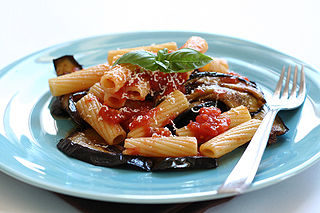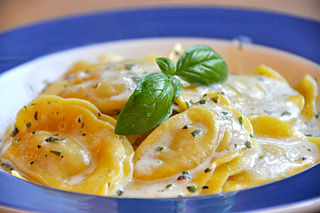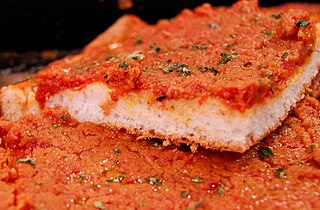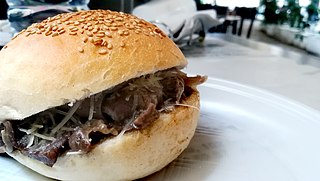
Cannoli are a pastry consisting of a tube-shaped shell of fried pastry dough, filled with a sweet, creamy filling containing ricotta—a staple of Sicilian cuisine. They range in size from 9 to 20 centimetres. In mainland Italy, they are commonly known as cannoli siciliani.

Sicilian cuisine is the style of cooking on the island of Sicily. It shows traces of all cultures that have existed on the island of Sicily over the last two millennia. Although its cuisine has much in common with Italian cuisine, Sicilian food also has Greek, Spanish, French, Jewish, and Arab influences.
"Mafia" is an informal term that is used to describe criminal organizations that bear a strong similarity to the organized crime groups from Italy. The central activity of such an organization would be the arbitration of disputes between criminals as well as the organization and enforcement of illicit agreements between criminals through the use of or threat of violence. Mafias often engage in secondary activities such as gambling, loan sharking, drug-trafficking, prostitution, and fraud.

Ravioli are a type of stuffed pasta comprising a filling enveloped in thin pasta dough. Usually served in broth or with a sauce, they originated as a traditional food in Italian cuisine. Ravioli are commonly square, though other forms are also used, including circular and semi-circular (mezzelune).
Cuccìa is a traditional, primarily Sicilian dish containing boiled wheatberries and sugar, which is eaten on December 13, the feast day of Saint Lucy, the patron saint of Syracuse. The dish is consumed in Sicily and in isolated pockets of southern Italy, as well as their communities abroad. It commemorates the relief from a food shortage in Sicily and the unexpected arrival of a cargo of wheat, which tradition says arrived in the port of Palermo on Saint Lucy's Feast in 1646. According to custom, bread should not be eaten on December 13; cuccìa should be the only source of wheat, and the primary source of nourishment for the day.

Arancini, also known as, depending on the region but also on the different areas of the same region, arancine, are Italian rice balls that are stuffed, coated with breadcrumbs and deep-fried. They are a staple of Sicilian cuisine. The most common arancini fillings are: al ragù or al sugo, filled with ragù, mozzarella or caciocavallo cheese, and often peas, and al burro or ô burru, filled with ham and mozzarella or béchamel sauce.

Sicilian pizza is a pizza prepared in a manner that originated in Sicily, Italy. Sicilian pizza is also known as sfincione or focaccia with toppings. This type of pizza became a popular dish in western Sicily by the mid-19th century and was the type of pizza usually consumed in Sicily until the 1860s. It eventually reached North America in a slightly altered form, with thicker crust and a rectangular shape.

Caponata is a Sicilian dish consisting of chopped fried eggplant/aubergine and other vegetables, seasoned with olive oil, tomato sauce, celery, olives, and capers, in an agrodolce sauce.

Panelle are Sicilian fritters made from chickpea flour and other ingredients, usually including water, salt, pepper, olive oil, and finely chopped parsley. They are a popular street food in Palermo and are often eaten between slices of bread or on a sesame roll, like a sandwich. These sandwiches, called pane e panelle, are usually served with a slice of lemon to be squeezed over the panelle.

Frittola is a traditional Sicilian street food from the Palermo region of Italy. It is similar to the frittole from Reggio Calabria, but seems to use calf parts instead of pig.

Pasta alla Norma, earlier called pasta con le melanzane, is an Italian dish of pasta and eggplant. It is typical of Sicilian cuisine, from Catania in particular.

Pani câ meusa, also spelled pani câ mèusa, is a Sicilian street food. Its Italianized name is panino con la milza. It is a dish typical of Palermo and it consists of a soft bread topped with sesame, stuffed with chopped veal lung and spleen that have been boiled and then fried in lard. Caciocavallo or ricotta may also be added, in which case the pani câ meusa is called maritatu ; if served without cheese, it is called schettu ('single') instead. It was created by Jewish butchers in Palermo, Sicily. It is sold mainly by street vendors in Palermo's main markets, such as the Vucciria and the Ballarò.

Maccu is a Sicilian soup and also a foodstuff that is prepared with dried and crushed fava beans and fennel as primary ingredients. Several dishes exist using maccu as a foodstuff, such as bruschetta al maccù and maccu di San Giuseppe, the latter of which may be served on Saint Joseph's Day in Sicily.

Pasta con le sarde is a Sicilian pasta dish with sardines and anchovies. It is recognised as a traditional Italian food product in the prodotto agroalimentare tradizionale (PAT) scheme of the Italian government. It is most associated with the city of Palermo, but it can be found all over the island.
Caldume (Italian) or quarumi (Sicilian) is a Sicilian dish of veal tripe stewed with vegetables, served as a street food in Palermo and Catania.
Pasta â Paolina is a pasta dish originating in the Italian city of Palermo. It was invented by a friar at the Monastery of San Francesco di Paola. Friars avoid meat consumption due to their traditional vow of poverty, so this dish is pescatarian and utilizes minimal ingredients. Traditionally it used bucatini, but now spaghetti is often used. It is made with anchovies, garlic, a small amount of chopped tomato, cinnamon, cloves, almonds, fresh basil and breadcrumbs.
Pasta chi vrocculi arriminati is a pasta dish originating in the Palermo region of Italy. It generally consists of a long pasta such as spaghetti or bucatini, cauliflower, onion, raisins, anchovies, pine nuts, saffron, red chili and breadcrumbs. Traditionally, it was made with bucatini. The name arriminati means 'mixed' and refers to the process of mixing until the cauliflower forms a creamy sauce.
Pasta 'ncasciata is a celebratory baked pasta dish originating in the Italian comune (municipality) of Messina, but today there are many versions from every province of Sicily as well as Calabria, in southern Italy. Ingredients vary according to the region as well as personal preferences. For example, while the dish usually uses two types of cheese, béchamel sauce may be used in lieu of one of the cheeses. It was traditionally baked in a dish placed over, as well as covered by, hot coals. The dish was made more well known by Andrea Camilleri's Inspector Montalbano.
Pasta ca nunnata is a pasta dish originating in the Sicily region of Italy prepared with newborn fish, which may be anchovies, sardines, red mullet or bream, as well as spaghetti, olive oil, garlic, parsley, white wine and black pepper. Sardines are most common and preferred, especially in the Palermo area. Where bream is used, the most common species is common pandora, known as luvari, uvari or luari in Sicilian. Tomatoes are sometimes added, but this is less common. The dish is also sometimes referred to as pasta ca sfighiata.

Spaghetti alla siracusana, also known as pasta fritta alla siracusana, is a pasta dish typical of Syracuse cuisine, widespread throughout Sicily.














